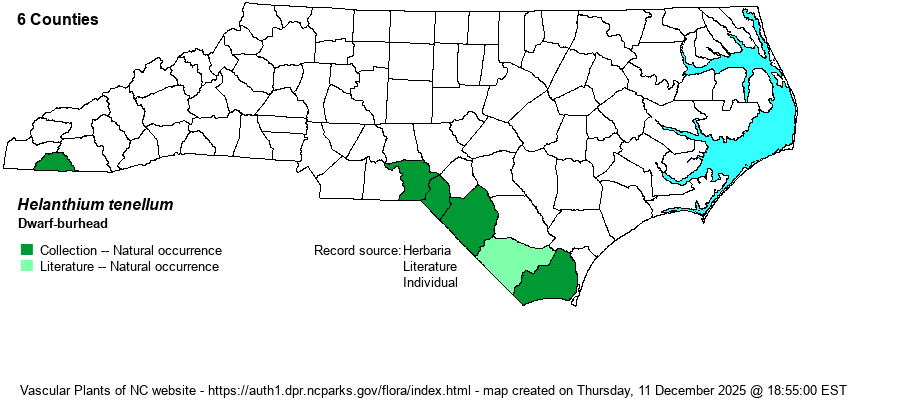| Section 5 » Family Alismataceae |
Show/Hide Synonym
| taxonName | relationship | relatedTaxonName | relatedTaxonRefText | relComments |
|---|
|
| Helanthium tenellum | = | Echinodorus tenellus | Flora of North America (1993b, 1997, 2000, 2002a, 2002b, 2003a, 2004b, 2005, 2006a, 2006b, 2006c, 2007a, 2009, 2010) | | | Helanthium tenellum | = | Echinodorus tenellus | Gleason (1952) | | | Helanthium tenellum | = | Echinodorus tenellus | Kartesz (1999) | | | Helanthium tenellum | = | Echinodorus tenellus | Flora of Virginia | | | Helanthium tenellum | = | Echinodorus tenellus | Wunderlin & Hansen Flora of Florida (3) | | | Helanthium tenellum | > | Echinodorus parvulus | Gleason (1952) | | | Helanthium tenellum | > | Echinodorus parvulus | Godfrey and Wooten (1979, 1981) | | | Helanthium tenellum | > | Echinodorus tenellus var. parvulus | Gleason and Cronquist (1991) | | | Helanthium tenellum | > | Helanthium parvulum | Small (1933, 1938) | | | Source: Weakley's Flora |
|
| Author | (Martius) Britton | |
| Distribution | Known only from a few Coastal Plain counties along the SC line (Richmond, Scotland, Robeson, Columbus, and Brunswick), plus one in the southwestern Mountains (Chatuge Lake, where it might be adventive). Interestingly, it was not known to occur in NC when RAB (1968) was published. It was considered of historical occurrence until re-discovered in Scotland County in 2019 by Bruce Sorrie, and in Richmond County in 2020 by Eric Ungberg.
This is a very sparsely distributed species but with a large overall range. It occurs sparingly north to MA and IL, and south to central FL and parts of TX. TN seems to have no records, and many states, including NC, have only a few county records. | |
| Abundance | Very rare and erratic in appearance from year to year, depending mainly on water levels, in the southern Coastal Plain. It is State Endangered. | |
| Habitat | This species has an ephemeral if not highly selective habitat, growing mostly on exposed mud of pond margins or creekbank drawdowns. Three sites are/were from clay-based Carolina bays, and such bodies of water can be dry in some seasons or years and fully ponded in others, both conditions that are not suitable for the plant to make an emergence. The 2019 site is from a well-surveyed clay-based bay, somehow having been "missed" all these years, perhaps owing to overly low water levels when previously surveyed. The 2020 site is a rare Sandhills depression pond. |
| Phenology | Blooms from June to September and fruits shortly after blooming. | |
| Identification | This species basically looks like a tiny clump of grass, with numerous leaves that are very narrow and only about 2 inches long. Actually, the blade (upper half of the leaf) is somewhat wider than the stalk, but at any distance this can be overlooked. It has a very slender but erect flowering scape, to about 3 inches tall, with 3 tiny white petals on each flower. The flowers are arranged in a sparsely branched inflorescence, such that a handful of flowers appear on each stem, each on a curved stalk. If you are lucky enough to catch the species in flower or fruit, with the thin scape that is about twice the height of the narrow leaves, you might notice this belly plant. Otherwise, if just in leaf, it likely will be overlooked. Such a tiny plant is certainly capable of "hiding" for a few years or even decades at a given pond, and thus we should not give up hope that it is permanently lost from historical sites in bays. | |
| Taxonomic Comments | This plant has gone through many, if not too many, name changes. It was originally included within Echinodorus, and named as E. parvulus or as E. tenellus. In recent years, it has -- not surprisingly -- been moved away from the robust and large burhead species of Echinodorus, into the genus Helanthium -- as H. tenellum.
| |
| Other Common Name(s) | Mud-babies, Pigmy Chain-sword | |
| State Rank | S1 | |
| Global Rank | G5? | |
| State Status | E | |
| US Status | | |
| USACE-agcp | OBL link |
| USACE-emp | OBL link |

